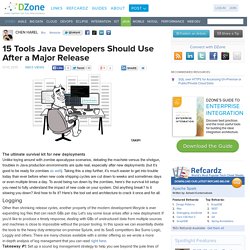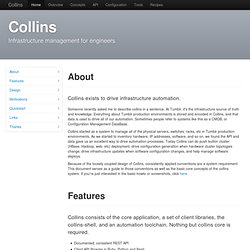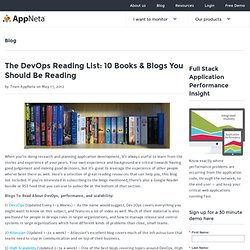

Consul by HashiCorp. What containers can do for you. If you read any IT news these days it’s hard to miss a headline about “the container revolution.”

Docker’s year-and-a-half-old engine had a monopoly on the buzz until CoreOS launched its own project, Rocket, in December. The technology behind containers can seem esoteric, but the advantages of bringing containers to your organization are more compelling than ever. And containers’ inherent portability opens up exciting new opportunities for how organizations host their applications.
15 Tools Java Developers Should Use After a Major Release. The ultimate survival kit for new deployments Unlike toying around with zombie apocalypse scenarios, debating the machete versus the shotgun, troubles in Java production environments are quite real, especially after new deployments (but it’s good to be ready for zombies as well).

Taking this a step further, it’s much easier to get into trouble today than ever before when new code shipping cycles are cut down to weeks and sometimes days or even multiple times a day. To avoid being run down by the zombies, here’s the survival kit setup you need to fully understand the impact of new code on your system. Did anything break? Deis/deis. Collins - Infrastructure Management for Engineers. Collins exists to drive infrastructure automation.

Someone recently asked me to describe collins in a sentence. At Tumblr, it's the infrastructure source of truth and knowledge. Everything about Tumblr production environments is stored and encoded in Collins, and that data is used to drive all of our automation. Sometimes people refer to systems like this as a CMDB, or Configuration Management DataBase.
Collins started as a system to manage all of the physical servers, switches, racks, etc in Tumblr production environments. Open Source IDS / IPS / NSM engine. The DevOps Reading List: 10 Books & Blogs. By Team AppNeta on May 17, 2012 When you’re doing research and planning application development, it’s always useful to learn from the stories and experience of your peers.

Your own experience and background are critical towards having good judgement and making good decisions, but it’s great to leverage the experience of other people who’ve been there as well. Here’s a selection of great reading resources that can help you, this blog not included. If you’re interested in subscribing to the blogs mentioned, there’s also a Google Reader bundle or RSS feed that you can use to subscribe at the bottom of that section. Monitoring Agent - Features. Zorka is a flexible java monitoring agent with programmable bytecode instrumentation engine.

It is designed to complement existing monitoring systems rather than duplicate their functionality. Zorka agent provides unparalleled flexibility due to its scripting capabilities which makes it unique among comparable products. In addition to core functionalities, set of scripts and zabbix templates distributed with agent provides monitoring capabilities for popular application servers (a.k.a. ‘batteries included’). End-user features (for application administrators) Zorka agent has been tested with JDK5, JDK6 and JDK7. Basic functionalities Zorka agent can act in several roles - depending on needs application administrator can enable desired functionalities and configure conventional monitoring systems accordingly. Monitored application components Standard java application components are supported in all application servers implementing such features: Specific components of other application (eg.
DevOps Bookmarks. Adaptive IT — Empathy: The Essence of DevOps. Revisiting What is DevOps. Two years ago, I wrote What is DevOps.

Although that article was good for its time, our understanding of organizational behavior, and its relationship to the operation of complex systems, has grown. A few themes have become apparent in the two years since that last article. They were latent in that article, I think, but now we’re in a position to call them out explicitly. Boxen. Open Source APM – Is it Possible to Do it Yourself? Recently as part of an engagement reviewing a customer’s performance engineering maturity level and looking at what Application Performance Management (APM) tools best fit their needs I was asked, “Why not do it ourselves?”

By that they meant a combination of log scraping, host metrics gathering etc. to trace critical business transactions end to end through their infrastructure. It is possible to do this, if you change your code, log a consistent transaction tracing call into every log, pull that back to some central location and do the required data analysis. Why Build Your Java Projects with Gradle Rather than Ant or Maven? For years, builds had the simple requirements of compiling and packaging software.

But the landscape of modern software development has changed, and so have the needs for build automation. Today, projects involve large and diverse software stacks, incorporate multiple programming languages, and apply a broad spectrum of testing strategies. With the rise of agile practices, builds must support early integration of code as well as frequent and easy delivery to both test and production environments. Established build tools regularly fall short in meeting these goals. How many times have your eyes glazed over while looking at XML to figure out how a build works? Gradle is the next evolutionary step in JVM-based build tools. In the Java world, a remarkably large number of libraries and frameworks are used. To get started with Gradle, all you need to bring to the table is a good understanding of the Java programming language.